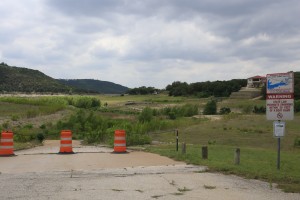As Highland Lakes Near Record Low, Will They Ever Fill Again?

Photo by REUTERS /JOSHUA LOTT /LANDOV
A man walks along Lake Travis after water receded during a drought in Austin, Texas September 10, 2011.
The combined storage of the Highland Lakes is expected to approach its record low – 30 percent full – by the end of this summer. After that, forecasters say, the El Niño weather pattern could bring some relief. But how much rain would it take to get them full again?
The total volume of water in the Highland Lakes, the main reservoir for a million people in and around Austin, fell to its lowest level since 1952 (during Texas’ multi-year drought of record) in September 2013. Water flowing into the Highland Lakes hit record lows — just ten percent the annual average — in 2011, Texas’ driest year on record.
Historically, low levels like the ones we’re seeing now have been corrected by massive rain events.
The last time the lakes were full was 2007, after 19 inches of rain fell in just 6 hours over Marble Falls, known as the ‘Marble Falls Rain Bomb.’ The drought of record in the 1950’s also ended with massive floods, and in 1981 storms dumped up to 11 inches of rain in around three hours in the Memorial Day floods.
If torrential rain were to bring a swift end to the Central Texas drought, it would need to drop between 15 and 20 inches over a fairly wide area of the Hill Country according to Bob Rose, a meteorologist for the Lower Colorado River Authority (LCRA). But many factors would influence how much rainfall actually makes it to the lakes.

Dylan Baddour/StateImpact Texas
The public boat ramp at Cypress Creek Park on Lake Travis has been out of use since the water receded past its end in 2011. Since then, the entire lagoon on which the park is situated has dried.
Projections by the LCRA put combined storage somewhere around 30 percent by September, but LCRA meteorologist Rose says chances are “pretty low” that the lakes would fall below 30 percent, a threshold that would trigger the most severe water restrictions in Central Texas.
“Even if the weather stays dry and we don’t see any rain all summer, we’ll probably stay just over that 30 percent going in to September,” said Rose. The lakes are currently 39 percent full.
The Climate Prediction Center forecasts an 80 percent chance of El Niño this fall, a global weather pattern which often brings above-average rains to most of Texas.
El Niño is a weather pattern triggered by warming in the tropical Pacific Ocean. It last occurred in 2009 and usually happens every two to four years. Conditions were mounting for El Niño in 2012 but the threshold was never reached, making Rose optimistic that it will happen this year.
That’s good news for farms, industry and more than 1 million people in and around Austin who rely on water from Lake Travis and Buchanan, collectively known as the Highland Lakes. Other forecasters aren’t sure that El Niño will be a beneficial one.
If the lakes fall bellow 30 percent combined capacity, the LCRA would declare a drought worse the Texas’ drought of record, cutting water supply for non-essential uses and instating mandatory 20 percent curtailment by industrial, agricultural and municipal customers.
“I would say based on history of previous El Niño events that I think much of Texas is going to see a change in the weather, heading toward a pattern of near-to-above-normal rainfall beginning in September and going through the winter months,” said Rose.

